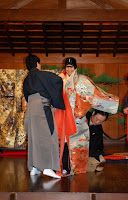On Sunday we returned to Osaka from a brief "free" weekend in Nishinomiya at Okuda-san's house. I was picked up by Tomofuji-san, my new host. On the way back into Osaka, he explained that there would be a family dinner party at his house that night, and that his niece and her Australian husband would be there. Though I was tired, it was a very nice dinner, and I enjoyed meeting everyone. Seamus was on the Australian Olympic fencing team; his wife Maki speaks great English and they have a cute 2-year-old daughter, Ami-chan.
The next morning was the last vocational day. I met a large group of people at the "Dai Biru" (big building) in Nakanoshima, the central business district located between two rivers.
The Dai Biru is an impressive building of 35 stories, with over 80,000 square meters of floor area. It uses river water for heating and cooling, and has operable vents in the floor plates to allow fresh air into the building.
After a presentation we made our way to the helipad on the roof. No railing, just a metal grating at the perimeter and then a 400-foot drop to the street below!
After a nice lunch at an Italian restaurant in the building, we continued on to Nanba to view some show houses. In Japan, custom residential design is even less common than it is in the United States.
Typically, a family wanting to build a house will look through a home builder's catalog, pick a house, and it will be completed within four or five months. I was impressed with the show houses-- a lot of good design had gone into them, and there were some nice features. Many of them had green roofs and courtyard spaces, a nice luxury in such a densely populated country.
That evening we had "chorus practice"-- yes, you read that correctly. District Governor Otani had translated the words to a song he wanted everyone to sing at the farewell dinner, so we practiced it for an hour or so, then went next door to an Okinawan restaurant owned by one of the Rotary Club members. Amazing food, and a good time. Okinawa is sort of the Hawaii of Japan, a laid-back tropical island that embraces a slower pace of life.
Tuesday we had a lunch meeting at the largest Rotary Club in Osaka, where I sat across from Mr. Mizuno (president of... Mizuno). It was our last presentation and didn't go off as smoothly as we had hoped, but it was fine. That afternoon we visited Douguya-suji (kitchen town) for some souvenir shopping, and saw a really nice little temple in the middle of the city.
Here's an image of the moss-covered statue that people throw water onto as they make an offering. We walked around a bit more, then headed back to our host families.
The next day we had a demonstration of bunraku, the classical Japanese art of puppetry. It takes three puppeteers to operate each puppet-- the head puppeteer generally must work for 35 years to make it to that point.
The novice puppeteer operates only the feet, and apprentices for 10-20 years. While the puppeteers operate the puppets, the chanters and
shamisen players narrate the story on an adjacent revolving platform.
Our lunch was a final
kaiseki extravaganza, though it was increasingly hard for us to eat all of the fish put in front of us... especially when it was a lobster wagon.
After lunch we walked around the Tsutenkaku area, where "moxibustion" (a sort of flaming acupuncture) was on offer. I passed, not having any particular ailments that I felt warranted being set aflame...
That night was my last with the Tomofuji family, and we went out for some yakisoba and okonomiyaki. In the morning I said goodbye to Momo the poodle and headed to the Hyatt Regency to prepare for the farewell banquet. I joined Bryan, Kathleen and Kasey in the restaurant, where I had my first cheeseburger and fries in a month. My stomach was completely unprepared...
The banquet was a lot of fun, and we got to see all of the families and other people who were so hospitable during our stay. Unfortunately we had audio-visual difficulties and weren't able to play our slide show, but I think everyone enjoyed the speeches. Next stop... Tokyo (with a brief visit to Kyoto)!



























































